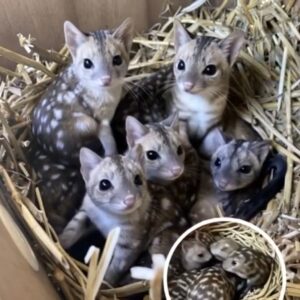Ecologists at Mt. Gibson Wildlife Sanctuary in Western Australia recently celebrated a moment that had been years in the making: the birth of the very first baby western quolls, also known as chuditch, at the site. This extraordinary event represents more than just a milestone in wildlife monitoring — it is a profound symbol of hope, resilience, and the positive impact of dedicated conservation work. During a routine survey, researchers were overjoyed to find the tiny marsupials safely nestled inside their mothers’ pouches, a moment that sparked excitement, relief, and deep admiration for the species’ tenacity. For the conservation team, these tiny lives were a tangible reminder that years of careful planning, dedication, and perseverance can truly make a difference in reversing the decline of vulnerable wildlife.
Western quolls, small carnivorous marsupials roughly the size of a domestic cat, are highly agile and predominantly nocturnal. Their diet consists mainly of insects, small mammals, birds, and reptiles, making them essential regulators within the ecosystems they inhabit. By controlling populations of smaller animals, western quolls help maintain a natural balance that is critical to ecosystem health. Without such predators, certain species can multiply unchecked, leading to imbalances that ripple across entire habitats. In this way, the quolls’ presence is not only a victory for the species itself but a significant contribution to the overall restoration of the local environment.
Historically, western quolls were widespread across mainland Australia, thriving in diverse habitats that ranged from forests to open woodlands. However, their populations declined dramatically over the last century due to multiple pressures. Habitat destruction, largely caused by agricultural expansion, urban development, and deforestation, left them with fragmented and limited living spaces. In addition, introduced predators such as foxes and feral cats preyed heavily on both adult quolls and their young. Human activity, including hunting and accidental trapping, also contributed to their decline. Today, western quolls survive in only a fraction of their historical range, making every successful reintroduction and breeding event a crucial step toward species recovery.
The Australian Wildlife Conservancy (AWC), a leading organization in species conservation and habitat protection, has spearheaded the efforts to restore quolls to their former ranges. Their approach is methodical and comprehensive, combining scientific research, careful planning, and hands-on management. Before releasing quolls into the sanctuary, each animal undergoes extensive health checks, and their habitat is prepared to minimize threats and ensure survival. Predator-proof fencing, supplemental food sources, and environmental enrichment are all part of creating a supportive environment for these delicate marsupials. Monitoring continues after release, with researchers tracking movements, behaviors, and interactions to ensure the population is thriving.
The discovery of the baby quolls at Mt. Gibson is particularly encouraging. It signals that the quolls are not just surviving but beginning to reproduce, a critical step in establishing sustainable populations. Successful breeding events are a clear indicator that the sanctuary’s environment provides the resources, security, and conditions necessary for the species to flourish. These births suggest that the quolls are adapting well to their restored habitat and are laying the groundwork for future generations that could eventually expand into neighboring areas, further strengthening the species’ recovery across Western Australia.
For the conservation team, witnessing the tiny joeys in their mothers’ pouches was a moment of profound joy and hope. Each small life represented the culmination of years of hard work, from fundraising and habitat restoration to volunteer coordination and fieldwork. Every donation, volunteer hour, and effort made to raise awareness has contributed to this achievement. The sight of these young marsupials is a powerful reminder of the real-world impact of community support, and it underscores how collective efforts can help reverse the decline of vulnerable species.
Beyond their intrinsic value, the quolls also play an essential ecological role. As predators, they help regulate the populations of smaller animals, preventing overgrazing and the overconsumption of native plants. This, in turn, supports a healthier environment for countless other species, from insects to birds and reptiles, creating a ripple effect that enhances biodiversity across the sanctuary. In this way, the successful reintroduction of quolls benefits not just the species itself but the broader ecosystem, highlighting the interconnectedness of all wildlife.
The births at Mt. Gibson also serve as a valuable opportunity for scientific research and education. Researchers can study the quolls’ behavior, growth rates, and interactions within the sanctuary, gathering insights that will inform future reintroduction projects. The sanctuary has become a living laboratory, where each milestone offers lessons for improving conservation strategies and ensuring long-term survival for the species. Additionally, these events inspire the public, demonstrating that wildlife recovery is achievable when humans intervene thoughtfully and responsibly.
For local communities, the arrival of these young quolls is a symbol of hope. It shows that even species on the brink of decline can recover when given a chance. Public engagement, whether through volunteering, donations, or advocacy, plays a pivotal role in supporting such outcomes. The tiny lives now thriving at Mt. Gibson are more than a conservation success; they are a vivid reminder that nature has the ability to heal and regenerate when nurtured and protected. Every step taken to safeguard these animals contributes to the restoration of balance within their ecosystems.
In conclusion, the birth of the first baby western quolls at Mt. Gibson Wildlife Sanctuary is a landmark achievement for conservationists, ecologists, and the broader Australian public. It represents hope, resilience, and the rewards of years of tireless dedication. By helping these quolls survive and reproduce, the sanctuary is playing a critical role in restoring ecological balance, enhancing biodiversity, and safeguarding a species that was once on the edge of extinction. These young marsupials are living proof that when humans work hand in hand with nature, recovery is possible, ecosystems can flourish, and the future of endangered wildlife can be secured for generations to come.
